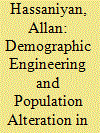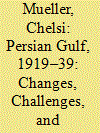| Srl | Item |
| 1 |
ID:
167218


|
|
|
|
|
| Summary/Abstract |
Studying the Iranian Kurdish question reveals the importance of the geopolitical location of the Kurdish region, which has left a massive impact on the framework and capability of the contemporary Kurdish national movement. Aware of this fact, different ruling regimes of Iran, considering territorial threats associated with the Kurdish nationalistic movement, implemented different policies of systematic “demographic engineering,” aimed at reducing the capability of the Kurdish claim for autonomy. Some aspects of the policy of demographic engineering implemented during the Safavid and the Pahlavi dynasties have been examined. Based on this, the article argues that the geopolitical location of the Kurdish region, as a buffer zone between the Ottoman and Safavid dynasties, has diminished and continues to undermine the capability of the Kurdish struggle for autonomy in Iran.
|
|
|
|
|
|
|
|
|
|
|
|
|
|
|
|
| 2 |
ID:
164400


|
|
|
|
|
| Summary/Abstract |
The interwar period (1919–39) was a formative period in the Persian Gulf. These years marked a transition from a Gulf society once characterized by symbiosis and interdependency to a sub-region characterized by national divisions, sectarian suspicions, rivalries and political tension. This period witnessed a surge of anti-colonial and nationalist feeling in Iran, the rise of a stridently nationalist military leader in the person of Reza Shah Pahlavi, his implementation of an assertive Persian Gulf policy and his re-assertion of Iran’s claims to coastal territories ruled by Arab shaykhs under British protection. The challenge posed by ascendant Iran to Britain’s dominant position in the Persian Gulf generated an abrupt shift from indirect to direct forms of colonial penetration in the Gulf Arab shaykhdoms and a transfer of Britain’s locus of power from the Iranian to the Arabian littoral. This article surveys the wide-ranging political, economic and social processes that transformed the Persian Gulf community into a sub-region of Arab-Iranian rivalry during the interwar period.
|
|
|
|
|
|
|
|
|
|
|
|
|
|
|
|